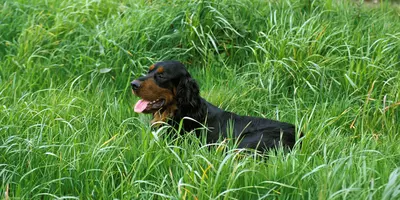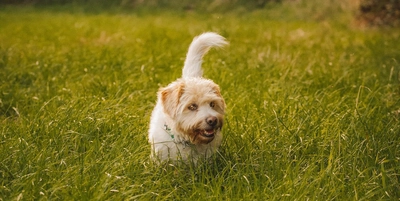Best Dog Food for Weight Gain
- 21 Dec 2019
- 7m read

We know that every dog is different, with their own shape and size and the occasional lump or bump. No judgement there – we're lumpy and bumpy, too.
But if you think your pooch is looking a little too slender (maybe they've lost some muscle recently, or you can easily see and feel their ribs, back and hip bones with no fat overlay) they could be underweight. And just like being overweight, it’s really not good for their health, making them vulnerable to problems including parasites and infections.
How to Tell if Your Dog is Underweight
A simple way to check if your dog is underweight is by performing a quick physical check. If your dog's ribs, backbone and hips are highly visible with little-to-no fat they could be underweight. If you look at them from above, an underweight physique will have an exaggerated waistline, rather than a healthy figure-of-eight body shape.

If you’re concerned, the best thing to do is take your pooch to the vet for a quick once-over. Vets use a system of body condition score (BCS) to tell you how your furry friend measures up, and they can also test for any underlying issues which may be causing weight loss.
Why Is My Dog Losing Weight?
A dog can be underweight for several reasons – they may not be getting the nutrients their body needs, they could be suffering from a disease such as diabetes, or perhaps you rescued them from a ruff situation (three cheers).
Dog Losing Weight but Eating
If your dog is losing weight, despite still eating their regular amount of food, then something else could be causing them to be underweight.
It could be as simple as the food that you're feeding your dog having poor nutritional value, so even if their bowl is overflowing, it could be inadequate for meeting their daily requirements. Alternatively, underlying illnesses, such as intestinal parasites or diabetes, could be affecting your dog’s ability to absorb the nutrients that their food should be providing.
Unfortunately, it can be really difficult to determine exactly what could be causing unexpected weight loss, so try not to jump to conclusions before getting advice from your Vet.
My Old Dog is Losing Weight
Sometimes as a pooch gets older, food just becomes less exciting. It can be down to health conditions or it can simply be a sign of old age. It can be really sad to see your dog lose interest in food but there are things you can do to try and entice them.
Opting for a dog food that is full of flavour and variety is a pawfect way to encourage them to eat. Whilst they might want lamb one day, turkey might tickle their fancy the next day. It is better to opt for a soft, easily-chewable and high-fibre food that is unlikely to contribute to dental or digestion issues. You can even add a splash of warm water to their food, or pop it in the microwave to make it extra-appealing.
Dental problems are a common occurrence in elderly dogs. Think about when we have toothache, some would argue that there is no greater pain and the last thing we would do is tuck into a meal.
A simple once-over from your vet can help identify any health concerns which may be causing them to turn their nose up at their food.
How to Put Weight on a Dog
Part of helping your dog to gain weight is to reunite them with their love of mealtimes. There is no quick fix for this and it can be quite a long process, but it’s necessary for their health and wellbeing.
Establishing a regular feeding schedule will also help your pup to become more comfortable. It may even be beneficial to add another mealtime into their day. Sometimes big meals can seem overwhelming and may discourage your dog from eating. If this is divided up into, let's say, three smaller meals throughout the day they may be more likely to have a nibble.
If you've adopted a rescue dog, it's especially important to get them into a regular routine, especially if they’ve developed the food aggression that's common in homeless pooches. Scheduled meal times will help your pup learn when their next meal is coming, thereby reducing their anxiety and need to guard their food.
We would recommend trying to stick to treat-giving as part of positive reinforcement. For example, when they’ve told you that they need the toilet or they have eaten some of their meal. Otherwise you could run the risk of your dog becoming a serial-snacker, rather than a main-meal attacker.
It may seem like a bit of an odd suggestion, but increasing your dog's exercise levels can also help with weight gain. The more energy that they are expanding, the more likely their body is to tell them that they need fuel. We would recommend exercising (pardon the pun) caution when doing so, to ensure that you’re finding the right balance between calorie intake and expenditure.
Finding the Best, Nutritionally-Complete Food for Your Dog
Your mind might immediately go to simply increasing your dog's potion sizes. Whilst this is part of weight gain, it is also down to quality, as well as quantity.
The nutritional value of dog foods can vary massively. Whilst one brand might choose to use quality protein and vegetable sources, other brands may include ingredients of lower nutritional benefit.
Because of this, you may find yourself giving your dog a smaller portion of good-quality food because it's more nutritionally dense. Meanwhile, the portion sizes of kibble and some wet food need to be large to meet daily intake requirements. Fresh dog food is a perfect example of this. Typically the portion sizes are smaller because they only include beneficial ingredients, such as meat, vegetables, legumes and herbs and so there’s no need to ‘bulk’ it out with unnecessary fillers.
Butternut Box is Perfect to Help Your Dog Gain Weight
Betsy was rescued from Romania, found barely surviving on the streets. She was severely underweight, but when she got to the UK her devoted pet-parent Dorothy started her on a regime of Butternut Box meals. Since then, Betsy has filled out nicely, her weight has risen and her coat, which was once falling out in clumps, is back to being shiny.
Our drool-worthy food is perfect for dogs like Betsy because it’s full of healthy nutrients from freshly prepared ingredients of the sort you could buy at the supermarket. Nothing chemical or industrial is included. It's gently cooked, making it easy to digest so it's gentle on sensitive tummies. The way we create our meals is exactly as you would if you cooked for your pooch in your own kitchen.
You just need to answer a few questions, telling us some details about your pup. Then our algorithm will work out the correct portion size and calories that they need at every meal to bulk up.
Butternut Box is a reassuring choice for pet parents to feed underweight dogs as each drool-worthy recipe has been created in partnership with animal nutritionists. They’ve even been tasted (yes, you read correctly) and approved by our in-house team and our vet. From Wham Bam Lamb to Pork of the Town, our tasty meals will tempt even fussy eaters to tuck in.
Choosing Butternut Box meals is also an ideal way to get organised as we are a subscription service. That means we'll send out a box full of deliciousness direct to your door as often as you need, usually every 2-4 weeks. Pop the food in the freezer and you'll never disrupt your pup's routine by running short. Our perfectly portioned pouches mean there's no measuring and no guesswork – just the right meal every time.




